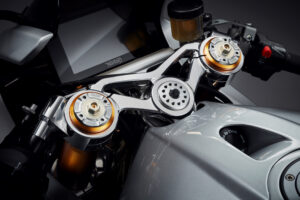
MotoGP, the pinnacle of bike racing, is set to enter an all-new era of sustainability and the FIM or Federation Internationale de Motorcyclisme has decided to embrace it with a new set of technical challenges for 2027. However, the fans seemed to be sceptical about whether these regulations improve the racing or dilute it. To find the answers to these questions and rider’s opinions, let’s have a comprehensive look at them!

Before we discuss the new regulations, we need to understand the current regulations and the need that creates for entering into a new era. For starters, the current regulation cycle allows for a 1000cc engine which will be reduced to an 850cc engine and will run on 100% sustainable fuel as opposed to 40% sustainable fuel. The aim here is to make the bikes more road-relevant and reduce top speed as well as increase mileage. The maximum bore will reduce from 81mm to 75mm, reducing performance. The hardcore fans have said that road relevance is what the WSBK or Super Bike World Championship is for. The maximum number of engines in a season will also reduce from 7 to 6. Not to mention, fuel tank capacity will reduce from 22 to 20 and 12 to 11 for the sprint. In our opinion, it doesn’t matter what engine is in the bike as today’s Moto3 class’ track times rival that the 500cc bikes in the time when Mick Doohan and Alex Criville were racing (that era ended in 2011). According to Aprilia mechanics, the overall package should produce 35hp less which doesn’t seem to bother many riders and mechanics.

The front fairing will be narrower from 600mm to 550mm and the nose will be pushed 50mm backwards increasing overtaking. Rear Seat Fairing will be allowed to upgrade only once per season. But according to riders, it isn’t as drastic as they expected. The aero limitations do not limit exploiting with lots of downforce and the narrowing of body components will have little effect on changing the aerodynamic nature of the machines. The various winglets allow the bikes to have a point-and-squirt type of handling. According to Luca Marini, this may exacerbate the difference between the manufacturers “because if you are clever and smart to find a way to make the aerodynamics work in a good way, it will affect a lot”.

The ban on Active Ride Height Devices has received praise or neutral feedback from the riders as that will put riders more in control and mistakes may happen a lot often like wheelies at full throttle and the track times will be scrutinized to a higher extent. This will separate good riders from the very best. Honda’s Joan Mir points out that this may create a variance in terms of the quality of starts. Overall, we do think that this is a welcomed improvement to simplify the bikes and allow drivers to have more technique.

The GPS Data allowance post-sessions is a rule that has been met with the most criticism. The reason for this rule was to make the sport safer and increase insight to viewers all around the world according to FIM. But, the broadcasting point of view, rumoured to be the primary motivator, to potentially level the playing field.



The last time MotoGP did an engine size change was in 2007 when they changed from 800cc to 990cc and was effectively undone 5 years later. In the eyes of Oliviera, “At least keep 1000cc. The [100% sustainable] fuel thing for me is also hard to understand. It’s expensive, the price per litre. Also, you’d have to have some companies certifying that for all the constructors, that has some costs applied to that. And also, developing a completely new way of making an engine go, with the 850cc…I think we have such a huge base and good experience with 1000cc, I think we could limit the costs much more, applying some kind of different technology to 1000cc than going to 850cc. But I’ll be happy to ride one of them, no problem!”

Ultimately, there is a philosophical difference in terms of riders’ opinions who have different things in their mind from the regulation cycle. It is important to understand that these 2027 regulations are intended to be a step back as there has been a dilution of racing whilst the chase for continuous technological improvement. This doesn’t mean that there won’t be complexity as that is a by-product of spending millions on developing a formula for racing in general. The impending effect should harm the racing less in future as MotoGP seems poised to enter the era of sustainability and allow real-world bike enthusiasts to enjoy their machines in times of rapid electrification and emission norms getting stricter and stricter.








